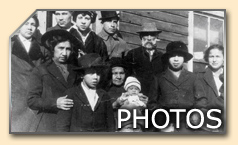
 The history of the Anishinaabe of Kettle and Stony Point begins prior to the first European contact circa the 16th and 17th centuries. However, the Anishinaabe were one of four groups who occupied south western Ontario; the Huron, Neutrals, and Iroquois also shared the use of land and resources with the Anishinaabe. During this time the flint trade was one of the most important trade goods in North America and the shore of Lake Huron surrounding Kettle and Stony Point was rife with flint or "chert" beds. Flint (Chert) was used for tools, weapons, and to make fire.
The history of the Anishinaabe of Kettle and Stony Point begins prior to the first European contact circa the 16th and 17th centuries. However, the Anishinaabe were one of four groups who occupied south western Ontario; the Huron, Neutrals, and Iroquois also shared the use of land and resources with the Anishinaabe. During this time the flint trade was one of the most important trade goods in North America and the shore of Lake Huron surrounding Kettle and Stony Point was rife with flint or "chert" beds. Flint (Chert) was used for tools, weapons, and to make fire.
Archaeologists have identified the flint from Kettle and Stony Point in locations as far away as the eastern and western coasts of North America and into the Southern United States. During this time wampum agreements between the four nations kept the peace in this territory; wampum such as "the dish with one spoon" that declared the shared rights of all four nations to feed their people with the land and resources of their common homeland.
Wampum shells were a trade commodity acquired from the east coast and the beads created from the shells were used to make wampum belts which carried the same significance as the treaties made with the European settlers in the centuries to come.
When the French and British began exploring the eastern woodlands and harvesting pelts for the fur trade the delicate peace between the four nations was overturned; new trade goods were introduced as well as weapons that the First Nations people had never seen before. The French allied themselves with the Anishinaabe peoples and the British found ready comrades with the Iroquois. The Neutrals, (so-called by Samuel de Champlain for their peacekeeping role in maintaining relations between the Huron, Anishinaabe, and Iroquois) were eradicated by the Iroquois with the sale of guns for pelts. The Iroquois then turned against the Huron and nearly decimated their population by the mid 1600's. the Huron fled south western Ontario and sought the aid of the Anishinaabe in central Ontario and a war was fought between the remaining Huron, their Anishinaabe allies and the Iroquois.
The Anishinaabe were successful in pushing the Iroquois back to their traditional territories along the St. Lawrence river in the Ottawa Valley and New York. Sadly, the Huron did not survive this battle.
**To hear more stories about Kettle and Stony Point First Nations - Click Here**




